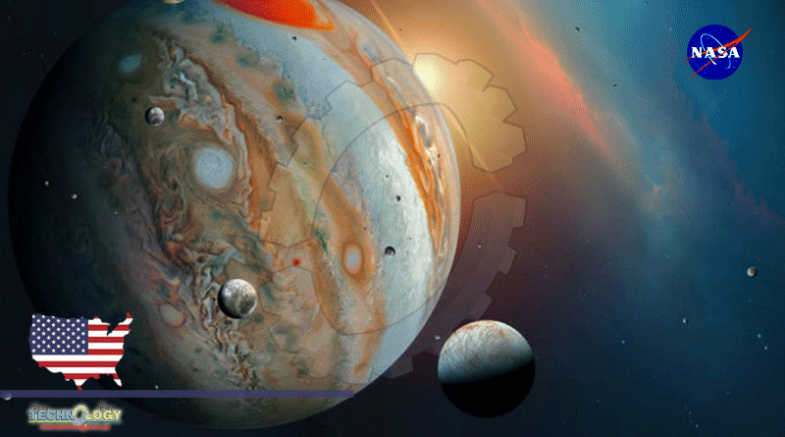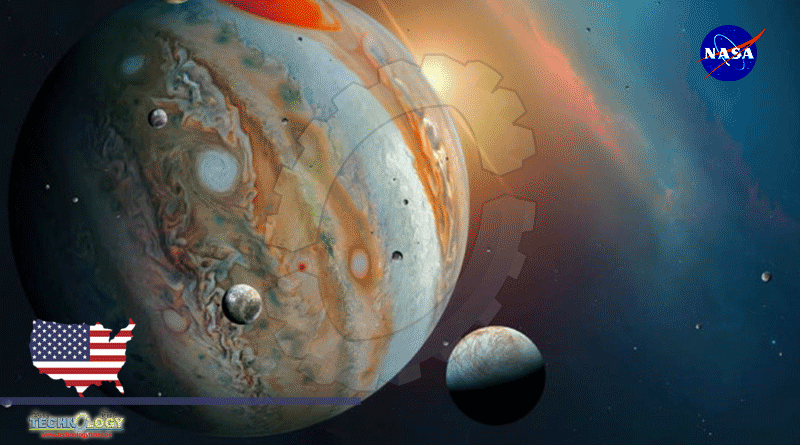Hubble Observations From 1999 To 2015 Show That Water Vapor Is Constantly Replenished In The Hemisphere Of The Moon

You might think that living half a billion kilometers from the sun wouldn’t be a home away from home. But planetary astronomers are very interested in exploring Europa’s moon in search of life. Slightly smaller than Earth’s moon, Europa’s monstrous orbit Jupiter. The temperatures of the frozen surface of the moon never exceed the freezing cold of 260 degrees below zero F. The temperature is so cold that water ice is as hard as rocks.
But under the solid icy crust there could be a global ocean with more water than on Earth. And where there is water, there can be life. Like a leaky garden hose, the ocean releases water vapor into space from geysers penetrating cracks in the surface, as first photographed by Hubble Space Telescope in 2013. The latest development comes from archival Hubble observations, spanning from 1999 to 2015, which revealed that water vapor is constantly being replenished in the hemisphere of the Moon. It’s a little vague. However, the atmosphere is only a billionth of the pressure at the surface of the Earth’s atmosphere. Water vapor was not directly seen, but the ultraviolet spectroscopic signature of oxygen was measured by Hubble. Oxygen is a component of water. Unlike geysers, this water vapor does not come from within Europe, but sunlight makes surface ice sublime. A similar atmosphere of water vapor was recently detected on Jovian Ganymede’s moon.
Europe is very exciting as a potential place to live and is the target NASAThe European Space Agency’s Europa Clipper and Jupiter Icy Moons Explorer (JUICE) – scheduled to launch within a decade. This image of Jovian moon Europa was taken in June 1997 from a distance of 776,700 miles by NASA’s Galileo spacecraft. Slightly smaller than Earth’s moon, Europa has a very smooth surface and the hard, icy crust has the appearance of cracked eggshells. The interior contains a global ocean with more water than that on Earth. It could be the home of life as we know it. Observations from the European Hubble Space Telescope revealed the presence of persistent water vapor in its extremely thin atmosphere. Hubble observations from 1999 to 2015 show that water vapor is constantly replenished in the hemisphere of the Moon. This is a different conclusion from the 2013 Hubble observations that found localized water vapor from geysers leaking from its underground surroundings. This water vapor comes from an entirely different process. Sunlight sublimates the surface ice and turns directly into gas. This Galileo color composite display combines purple, green, and infrared images. A view of the moon is displayed in natural color (left) and enhanced color designed to highlight subtle color variations on the surface (right). The bright white and bluish portion of Europa’s surface consists mostly of water ice, with very little unglazed material. The long, dark streaks are fractures of the crust, some over 1,850 miles long. Galileo’s mission ended on September 21, 2003, when the spacecraft was deliberately ordered to dive into Jupiter’s atmosphere, where it was destroyed. However, to this day, scientists continue to study the data that he collected. The Jet Propulsion Laboratory (JPL) in Pasadena, California managed the Galileo mission for NASA’s Office of Space Science in Washington, DC. JPL is an operational division of the California Institute of Technology (Caltech). This photograph, images, and other data from Galileo are posted on the Galileo Expedition homepage. General information and educational background images are also available. Credit: NASA, NASA-JPL, University of Arizona
Observations by NASA’s Hubble Space Telescope of Jupiter’s icy moon Europa have revealed the presence of persistent water vapor — but, mysteriously, only in one hemisphere. Europe is home to a vast ocean beneath its icy surface, which can provide suitable conditions for life. This finding enhances astronomers’ understanding of the icy moons’ atmospheric structure and helps lay the foundation for planned science missions in the Jovian system, in part, to explore whether an environment half a billion kilometers from the Sun could support life.
Previous observations of water vapor over Europe have been associated with the eruption of plumes of ice, photographed by Hubble in 2013. They are similar to hot springs on Earth, but extend more than 100 kilometers in height. They produce transient droplets of water vapor in the Moon’s atmosphere, which are only a billionth of the pressure at the surface of Earth’s atmosphere. The new results, however, show similar amounts of water vapor distributed over a larger area of Europe in the Hubble observations spanning from 1999 to 2015. This indicates the long-term presence of a water vapor atmosphere. Water is only in the back hemisphere of Europa – that part of the Moon that is always opposite to the direction of its motion along its orbit. The cause of the asymmetry between the anterior and posterior hemispheres is not fully understood.
The discovery comes from a reanalysis of archival footage and spectra from Hubble, using a technique that recently led to the detection of water vapor in the atmosphere of Jupiter’s moon, by Lorenz Roth of the Royal Institute of Technology, Space and Plasma Physics in Sweden. . “The observations of water vapor over Ganymede and the backside of Europa enhance our understanding of the icy moons’ atmosphere,” Roth said. “However, the discovery of Europa’s stable water abundance is a bit more surprising than its discovery at Ganymede because Europa’s surface temperatures are lower than Earth’s surface temperatures at Ganymede.” Europa reflects more sunlight than Ganymede, making the surface 60 degrees Fahrenheit cooler than Ganymede. During the day the altitude freezes over Europe to minus 260 degrees Fahrenheit. However, even at lower temperatures, the new observations indicate that water ice is sublime — that is, it transforms directly from a solid to vapor without a liquid phase — from Europa’s surface, just as it is at Ganymede.
To make the discovery, Roth delved into the archival data sets of the Hubble telescope, selecting ultraviolet observations from Europe from 1999, 2012, 2014, and 2015 while the moon was in different orbital positions. All of these observations were captured using the Hubble Space Telescope (STIS) Imaging Spectroradiometer. STIS ultraviolet observations allowed Roth to determine the abundance of oxygen – a component of water – in Europe’s atmosphere, and by interpreting the strength of the emission at different wavelengths, he was able to infer the presence of water vapor. This discovery paves the way for in-depth studies of Europe through future investigations including NASA’s Europa Clipper and the European Space Agency’s (ESA) Jupiter Icy Moons Explorer (JUICE) mission. Understanding the formation and evolution of Jupiter and its moons also helps astronomers better understand Jupiter-like planets around other stars.
This news was originally published at Pakistan Christian
